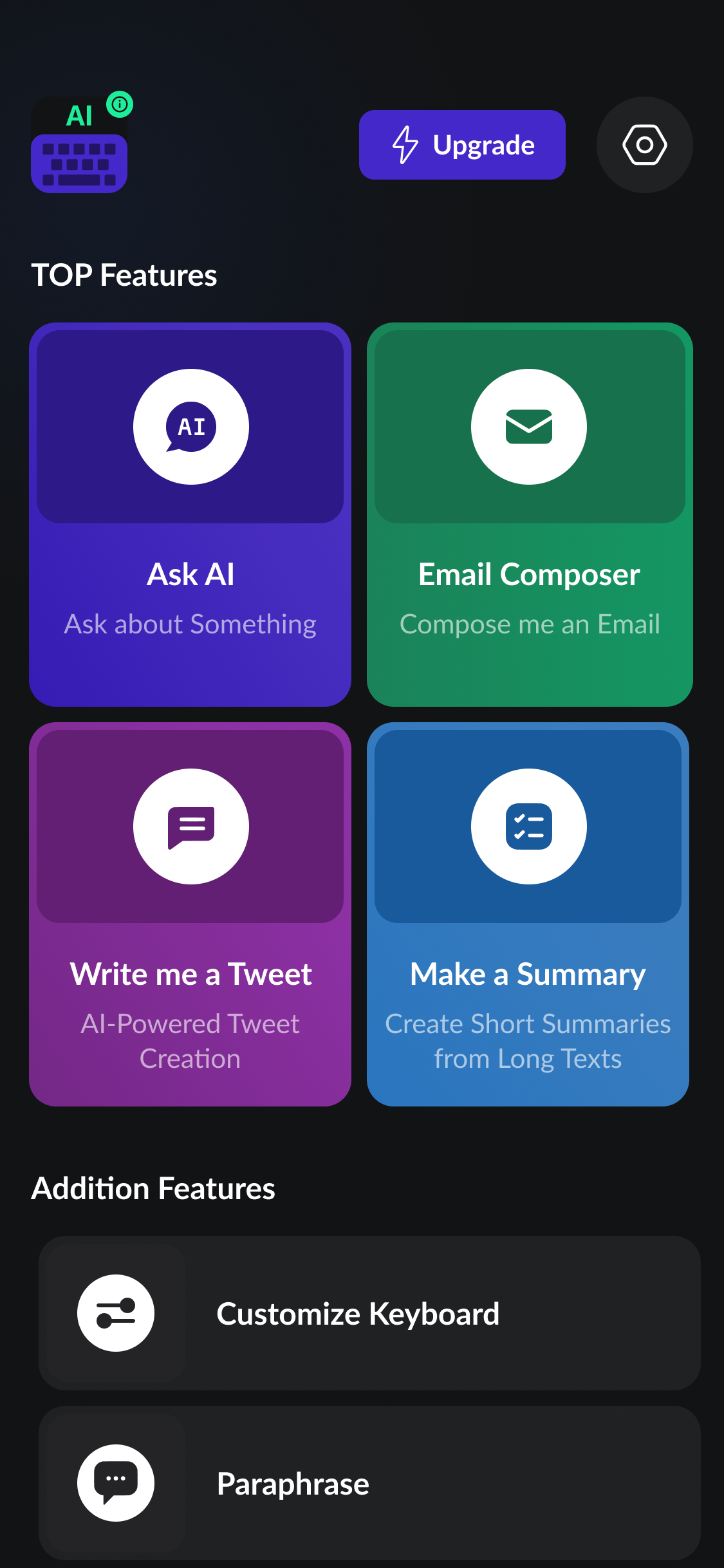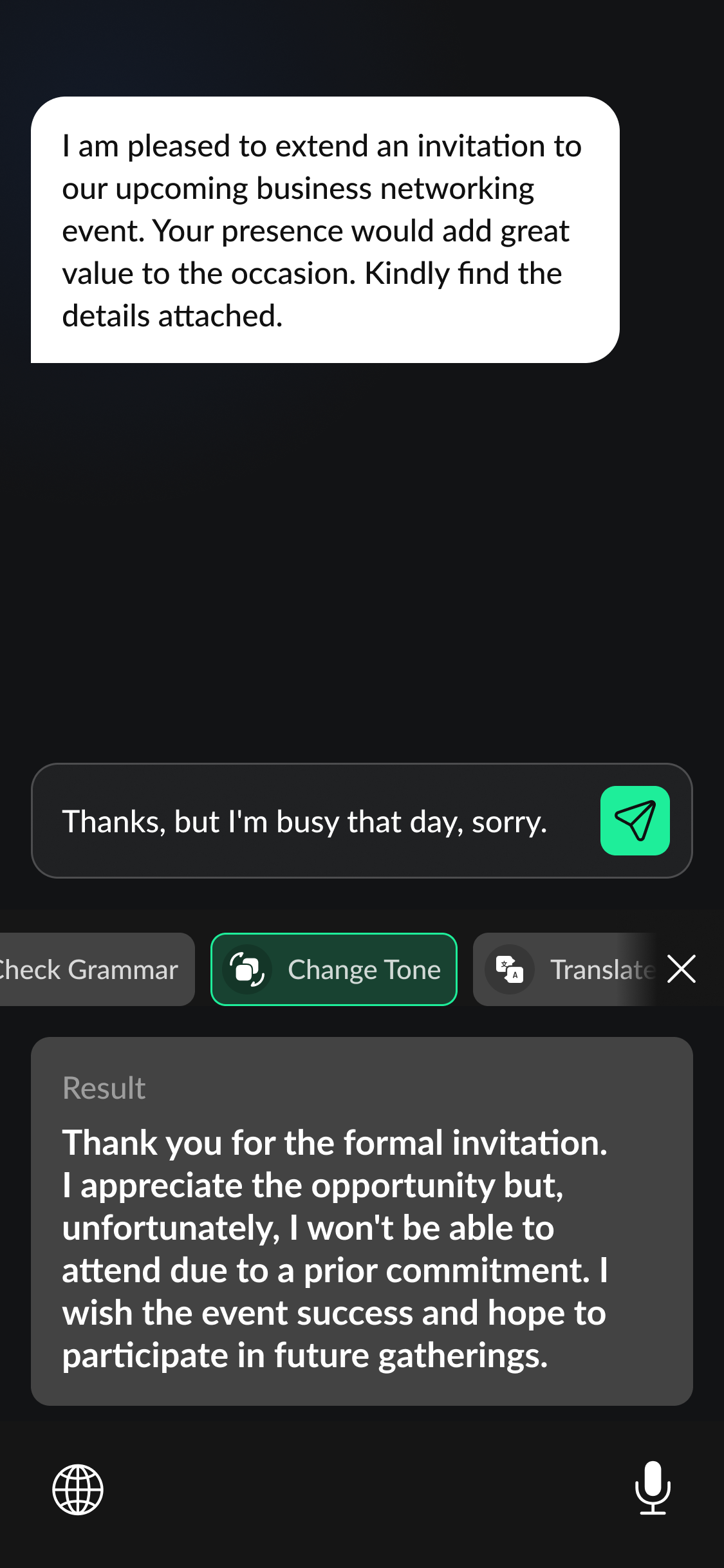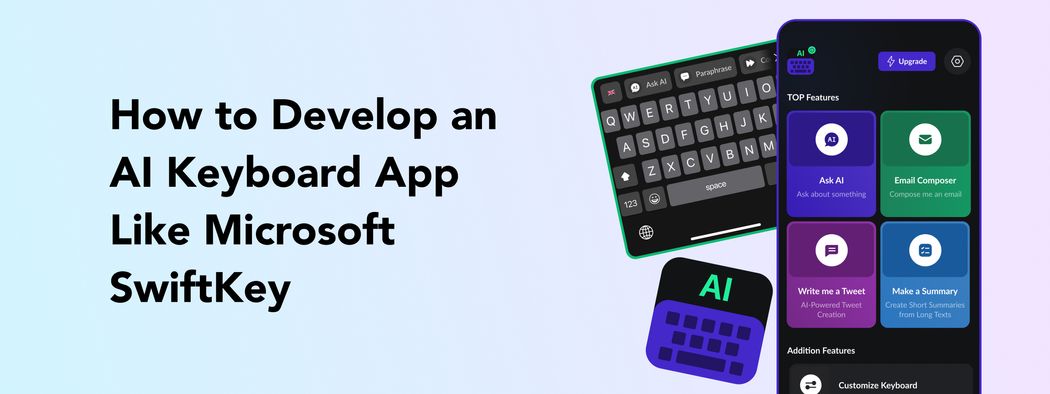Keyboard autocorrect suggestions on smartphones have been saving users from embarrassing typos and grammatical mistakes in their texts for years now. A new generation of smartphone keyboards offers more than simply correcting mistakes — an AI-based keyboard can predict words, choose the best-fitting sentence endings, or even write a whole message based on a prompt. Yes, you can ask it to write a joke instead of you, too.
This article describes the top features of a smart keyboard app and the main steps of developing an AI keyboard app based on Perpetio's AI Assistant GPT application.
What is Microsoft SwiftKey?
Microsoft SwiftKey is a mobile keyboard app that runs both on iOS and Android. It works as an add-on keyboard that replaces the built-in one on a smartphone. The main difference between a standard iPhone or Android keyboard and Microsoft SwiftKey is the added AI functionality the latter offers.
SwiftKey offers several AI-based features for faster and more accurate typing, like
- Correction of spelling errors
- Predicting the next word or phrase in a sentence
- Copilot AI bot support to write messages based on prompts
- Slide-typing functionality, allowing users to type with one hand by sliding between letters
- Cloud clipboard for copying and pasting text between smartphone and Windows PC
- Multiple language support
- Emoji search bar
- GIF and sticker search and theme categorization
- Keyboard visual themes
With such convenience, it’s no wonder Microsoft SwiftKey has become one of the most popular keyboard apps worldwide. Its AI-powered features not only enhance typing speed and accuracy but also adapt to users' typing styles over time, making the typing experience more personalized and efficient.
What are the Main Microsoft SwiftKey Alternatives?
Microsoft SwiftKey isn’t the only option for those looking for ways to type with ease. Several alternatives exist for different platforms, functionality, and design tastes.
Wordtune
Wordtune is another popular AI keyboard that offers users to write both work emails and casual texts with the help of artificial intelligence. As of now, there is only an iOS Wordtune app.
Apart from standard autocorrect, emoji search, and autofill functionality, Wordtune has two special AI-based features:
- Create with AI to get a fully AI-written text based on a short prompt
- Rewrite to edit a text written by the user, improving its grammar, structure, and tone of voice. Users can choose between several options on how to change the text, like shorten, extend, make more formal, etc.
While AI assistance is additional functionality for Microsoft SwiftKey, Wordtune focuses on AI writing and editing, making the keyboard a small AI helper always on screen.
Grammarly
A popular online grammar-checking service has also released its own smart keyboard app. Grammarly keyboard has the same basic text correction functionality as the web version of Grammarly. The keyboard app underlines grammatical, stylistic, and structural issues in a text and offers replacements to improve the text. Plus, the Grammarly keyboard has a tone analysis feature to detect if the text matches the user’s intended style.
Case Study: Perpetio's AI Assistant GPT App
AI Assistant GPT is a mobile keyboard app developed by Perpetio. This keyboard is powered by GPT-4.0 API and becomes an all-in-one AI assistant for typing. Among the main features of AI Assistant GPT app are:
- Grammar and spelling analysis: AI Assistant GPT ensures crystal-clear writing in 10 diverse languages.
- Smart word enhancement: Our refined AI proposes the finest word alternatives, making sure your expression shines and resonates.
- Instant translation: Users can transition fluidly across languages with our embedded real-time translation, simplifying multilingual conversations.
- AI-powered message extension: AI Assistant GPT grasps the context and seamlessly continues your text, amplifying writing efficiency.
- Paraphrasing tool: Users can transform prose with inventive paraphrasing and craft originality while maintaining their core message, all plagiarism-free.
Perpetio’s development team used GPT 4.0 API to integrate the AI chat functionality into a keyboard app. The GPT-4.0 API, developed by OpenAI, is a natural language processing (NLP) model designed to generate human-like text based on input prompts.

Relying on deep learning algorithms and trained on extensive datasets of human language, GPT-4.0 demonstrates remarkable proficiency in understanding and producing contextually relevant text across a wide range of topics and contexts.
Key features of the GPT-4.0 API include text generation capabilities, contextual understanding, and support for multiple languages. And that’s exactly what we needed for our smart keyboard app.
Perpetio's developers relied closely upon the API documentation, experimenting with different configurations to optimize performance. By implementing advanced algorithms and data structures, they ensured minimal latency and a seamless user experience, delivering lightning-fast responses and high-quality text generation in real time.
We then implemented the necessary code to establish communication between the AI Assistant GPT app and the GPT-4.0 API, handling authentication, authorization, and data exchange.
Our design team placed a convenient bar atop the keyboard, providing users with easy access to all the keyboard's features, including text generation and spelling correction. This design choice ensures that users can seamlessly toggle between different functionalities without cluttering the screen or disrupting their typing flow.
Additionally, Perpetio incorporated functionality within the app itself for users who prefer to generate text outside of the keyboard interface. This flexibility allows users to harness the app's advanced text generation capabilities in various contexts, whether composing emails, drafting documents, or engaging in social media conversations.

To enhance the overall user experience, Perpetio employed a vibrant color scheme characterized by bright, neon-like colors contrasted against a black background. This minimalistic design aesthetic not only creates a visually striking interface but also directs the focus squarely on the text, ensuring optimal readability and usability.
Key Features for an AI Keyboard App
Based on the AI keyboard app we developed, we share the main features of a similar application to make it both functional and convenient for the users.
Prediction algorithms for word suggestions
One of the key features of an AI keyboard app is its prediction algorithms, which analyze the context of a user's text input to provide accurate word suggestions. These algorithms use machine learning and natural language processing techniques to predict the next word or phrase in a sentence, significantly speeding up the typing process and reducing errors. By continuously learning from user interactions, AI keyboards become more personalized over time, adapting to individual typing styles and preferences.
Customization options for themes and layouts
To cater to diverse user preferences, AI keyboard apps offer a range of customization options for themes and layouts. Users can choose from a variety of visually appealing themes, including different colors, patterns, and textures, to personalize their keyboard interface.
Multilingual support and language prediction
AI keyboard apps boast multilingual support, enabling users to type and get text suggestions in multiple languages. Based on the app’s target region and audience, the number and selection of languages can vary. Adding English as an option is always a good idea as it is a language of international communication, and many users might need help writing texts in English, which can be a foreign language for them.
Tone and style analysis
Another feature of AI keyboard apps is tone and style analysis, which evaluates the tone, style, and grammar of a user's text input to provide suggestions for improving clarity, coherence, and effectiveness.
Using natural language processing techniques, AI keyboards can detect subtle nuances in language usage, such as formality, politeness, or emotional tone, and offer suggestions to enhance the overall quality of the text.
This feature is especially valuable for professional communication, where clarity and precision are paramount, as well as for creative writing, where style and tone play a crucial role in conveying meaning and emotion.

Grammar error and typo correction
Smart keyboard apps also include grammar error and typo correction features, which automatically identify and correct common grammatical mistakes and typos in the user's text input.
These apps analyze the context of the text to suggest corrections for spelling errors, punctuation mistakes, subject-verb agreement issues, and more. By providing real-time feedback on grammar and typos, AI keyboards help users write more accurately and effectively, enhancing the overall quality of their written communication.
How to Develop an AI Keyboard App
Let’s review the basic steps of developing a smart keyboard app to offer you clarity on what lies ahead.
Defining the scope and objectives of the project
This step involves clearly outlining what the AI keyboard app aims to achieve and what problems it solves for users. Unlike standalone apps, a keyboard app serves as an add-on to existing interfaces, requiring seamless integration with various platforms.
For example, Perpetio outlined the objectives of our AI Assistant GPT app to enhance users' writing experience by providing AI-powered text generation, correction, and multilanguage support features. Plus, we decided to make this functionality available both as an add-on keyboard and in the app.
Choosing the right technology stack for development
The choice of the appropriate technologies and programming languages for building the app depends on the target platform (iOS or Android) as well as the app’s target functionality.
For example, we at Perpetio opted for native iOS development and integrated the GPT-4.0 API for AI capabilities.
When integrating AI capabilities into your keyboard app, you have several options for acquiring the necessary technology. You can purchase APIs from AI companies like OpenAI, which offer pre-trained models like GPT-4.0 for text generation. Alternatively, you may modify existing APIs to better suit your app's needs or attempt to create your own AI models. For example, you can add an extra training data set to enhance keyboard suggestions on, let’s say, legal texts if you plan to work a domain-specific smart keyboard.
However, creating custom AI models requires access to large datasets for training, which can be challenging and resource-intensive. Evaluate the pros and cons of each approach based on your project requirements and available resources.
Designing the user interface and experience
A highly important step in building an AI-based keyboard app is to design a user-friendly interface that is intuitive and visually appealing. Designing a keyboard interface involves balancing functionality with aesthetics and usability, especially considering the limited space available. Unlike traditional app interfaces, keyboards are compact and require careful optimization to fit essential features without sacrificing usability.
Designers must use the available space wisely, prioritizing must-have features while ensuring a seamless user experience. When designing the keyboard interface, consider the layout, color scheme, and visual elements to maximize usability and appeal. Given the limited space on smaller screens, like mobile devices, prioritize simplicity and intuitive design to enhance usability.
Remember that the design of the keyboard has to match Apple’s and Google’s design practices and standards.
Perpetio focused on creating a minimalistic design with bright colors and a black background to emphasize text readability and make the AI keyboard app visually engaging and easy to use.
Integrating customization options and settings
It’s best if you can offer your users customization options to tailor the app to their preferences. Perpetio included customization features such as theme selection and layout customization in our AI keyboard app to enhance user personalization and satisfaction. Plus, users can choose between a number of languages and select which features to display on the keyboard.
Testing the app for functionality, performance, and usability
Thoroughly test the app to ensure it functions as intended, performs well, and provides a seamless user experience. Perpetio conducted careful testing of our AI Assistant GPT app to identify and address any bugs or issues before launch, ensuring a smooth and reliable user experience for their customers.
Consider Perpetio Your Trusted Partner
In conclusion, with the increasing popularity of AI tools, many users are seeking convenient text-generation solutions integrated into their keyboards. Currently, there's relatively low competition in this space, presenting a promising opportunity for businesses to tap into. At Perpetio, we've already launched our own smart keyboard product and are excited to assist other businesses in leveraging generative AI APIs to create innovative and user-friendly solutions.
Let's work together to make the most out of this emerging technology and enhance the writing experience for users everywhere.





